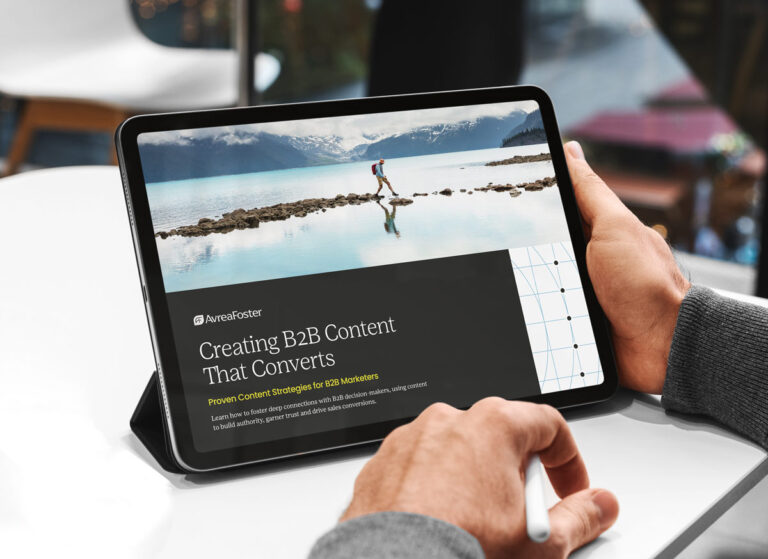Managing brand equity is complex for any business. Add to that the intricacies of being a B2B brand that’s undergone a recent acquisition or merger, and it can feel especially daunting. Part of that relates to how brand image impacts brand equity. A brand’s name, logo, colors and other visual trademarks help shape brand perception and that, ultimately, affects the commercial value of the brand. When a business takes on additional brands, it is left with a critical decision: to separate or integrate brand identities. That decision can make or break the success of any acquisition.
Most brand managers will find it difficult to give an unbiased assessment of the brand, understandably — much less compare that brand’s strengths and weaknesses against a brand (or two or three) that have been recently added to the portfolio. That’s in part why AvreaFoster is brought in to conduct discovery and research around brand transitions and offer an honest, third-party perspective. As we dig in to deep research and interviews, we typically keep in mind four visual brand transition strategies that we might apply to varying degrees.
01
No Change to Brand Identity
It’s possible the path to a successful integration means no visual integration at all. In other words, making zero changes to the visual brand of the acquired or acquiring businesses. This doesn’t mean the brands operate separately, but that the market sees no change. Typically, this strategy only applies when two very mature brands merge and linking one visually to another might undercut each brand’s position. This also applies when two or more equitable brands appeal to very distinct and dramatically different audience segments.
The “no change” strategy is a rarity in the B2B world. For the most part, B2B companies use M&A as a growth strategy — the success of which demands the acquiring brand be able to signal to the market its expanded offering. It’s also worth noting that sticking to the status quo can seem like the conservative approach, but it can sacrifice significant potential profits. It can also wreak havoc on morale. When brands are kept separate but equal, employees tend to segment themselves similarly — or worse, develop an unhealthy competitive spirit that chips away at a single shared vision.
02
Hybrid Brand Identity
An alternative to doing nothing, and one often used in the B2B realm, is the hybrid transition strategy. This is an ideal choice when two or more brands on equal footing in the market come together. As a bold and dramatic signal to their stakeholders, they might combine their names and/or visual brand elements to mark a new path forward. One example is ExxonMobil. The two brands, Exxon and Mobil, merged in 1988 and also decided to merge their names and brand look.
There is no exacting formula as to what visual elements might change in a hybrid strategy or even whether new elements might be introduced. Often when merging brand names, businesses opt to create a wholly new logo or logomark. The bevy of options available in a hybrid strategy make it even more important to take a thoughtful approach — analyzing which elements stand out more than others in market and which seem to signal value to stakeholders. When done right, a hybrid brand identity combines brand equities to reduce possible alienation of customers and employees while improving adoption and activation in market.
03
Parent-Driven Brand Identity
Frequently, one brand is seen as the more dominant identity. Perhaps the acquiring brand name and logo is recognized globally, while the acquired brand is national. However, as we see often in B2B, the rationale behind the acquisition was likely spurred by the acquired company’s growth trajectory. To fully transition the acquired brand to the acquiring company brand could disrupt that growth. In this scenario, we often see a parent-driven brand transition plan take effect.
This strategy involves a dual, but segmented visual brand identity in which both brand names and logos are used simultaneously, yet under an agreed-upon hierarchy. Alternatively, the acquired company might use its name and logo alone, but with an identifier that signals they are part of the acquiring business.
While it’s not always the case, this strategy is usually used for a set period, allowing stakeholders time to build trust. Some leaders balk at the thought of what might be perceived as transitioning a brand twice, but the additional cost of a two-phase approach is a drop in the bucket compared to the cost of a failed acquisition.
04
All-New Brand Identity
The choice made by newly merged brands ready to undergo a significant transformation is to develop an entirely new brand identity — new name, new logo, new brand look and, with all that, a new website and sales and marketing materials. Yes, it can be the costliest of the brand transition options, but it can also significantly improve the futures of all brands involved.
Typically, this strategy is applied to cases in which merging brands are struggling to maintain their relevancy. Maybe they have had challenges delivering services or products that meet consumer demands. Perhaps the industry has shifted so that the merger was required to meet changing expectations. By cutting ties with their past identities and creating one wholly new brand name and look, the brands can communicate a shared, innovative vision to their stakeholders.
Conclusion
Whatever the situation, there is a way to transition a brand identity — even those with significant equity — to improve outcomes post M&A. AvreaFoster has transitioned many brands to the benefit of their employees and their bottom line.
Next Steps
Now that you’ve looked at brand image strategies, let’s talk launch. Read part three in this three-part series: Harnessing the Brand to Grow the Business Post Merger.
AvreaFoster has significant experience and interesting case studies to share with brand and marking leaders interested in understanding more about managing brand momentum post M&A. Let’s talk.



